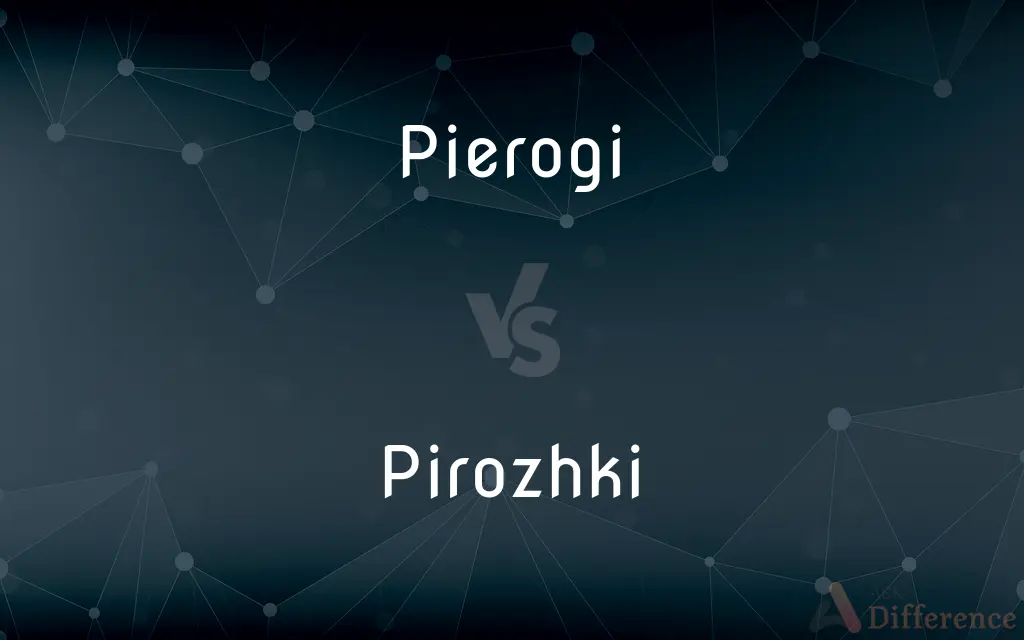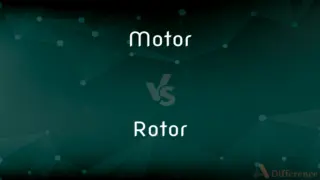Pierogi vs. Pirozhki — What's the Difference?
Edited by Tayyaba Rehman — By Maham Liaqat — Updated on April 20, 2024
Pierogi are filled dumplings of East European origin, typically boiled, whereas pirozhki are small Russian pastries, stuffed and either baked or fried.

Difference Between Pierogi and Pirozhki
Table of Contents
ADVERTISEMENT
Key Differences
Pierogi are a staple in Eastern European cuisine, particularly in Polish cooking, consisting of dough dumplings stuffed with a variety of fillings, such as potato, cheese, meat, or fruit. On the other hand, pirozhki hail from Russian cuisine and are small pastries filled with diverse ingredients like meat, vegetables, or fruits, and can be either baked or fried.
The dough of pierogi is unleavened and boiled, similar to that of other dumpling varieties. Conversely, pirozhki dough is often yeasted and airy, resulting in a light, bread-like texture when baked or a crispy outer layer when fried.
Pierogi are typically served as a main dish or a side, frequently topped with onions, sour cream, or butter. In contrast, pirozhki can be found as a snack or a light meal, popularly consumed on the go in many parts of Eastern Europe.
Another distinction lies in their preparation and presentation; pierogi are always boiled and sometimes fried after boiling for a crispy exterior, while pirozhki are never boiled but always cooked by baking or frying.
Comparison Chart
Origin
Eastern European, notably Polish
Russian
ADVERTISEMENT
Dough Type
Unleavened, boiled
Yeasted, baked or fried
Typical Fillings
Potatoes, cheese, meat, fruits
Meat, vegetables, fruits, eggs
Serving
Main dish, side dish, topped with onions or sour cream
Snack, light meal, standalone
Texture
Soft, sometimes crispy when fried
Light and airy or crispy
Compare with Definitions
Pierogi
A traditional Polish dish served with a variety of toppings.
We topped the pierogi with sour cream and chives.
Pirozhki
Can be sweet or savory, reflecting versatility.
She enjoyed a sweet pirozhki with apple filling after dinner.
Pierogi
Dumplings made of unleavened dough, boiled and often fried.
She cooked pierogi filled with cheese and potatoes.
Pirozhki
Known for their yeasted dough and light texture.
The pirozhki had a fluffy, bread-like texture that everyone loved.
Pierogi
Can be sweet or savory.
For dessert, we had sweet pierogi filled with fresh berries.
Pirozhki
Small Russian pastries, typically filled and either baked or fried.
I brought homemade pirozhki stuffed with cabbage to the party.
Pierogi
Associated with Eastern European cuisine.
Pierogi are a beloved dish in many Eastern European countries.
Pirozhki
Filled with a variety of ingredients.
The pirozhki were filled with minced beef and onions.
Pierogi
Typically crescent-shaped and stuffed.
The pierogi were perfectly crescent and steaming hot.
Pirozhki
Commonly eaten as a snack or quick meal.
He grabbed a pirozhki on his way to the meeting.
Pierogi
Pierogi ( pih-ROH-ghee) are filled dumplings made by wrapping unleavened dough around a savoury or sweet filling and cooking in boiling water. They are often then pan-fried before serving.
Pirozhki
Pirozhki (Russian: пирожки́, tr. pirožkí, IPA: [pʲɪrɐʂˈkʲi], plural form of pirozhok; Ukrainian: пиріжки, pyrizhky) are Russian and Ukrainian baked or fried yeast-leavened boat-shaped buns with a variety of fillings.
Pierogi
A semicircular dumpling with any of various fillings, such as finely chopped meat or vegetables, that is often sautéed after being boiled.
Pirozhki
Small pastries filled with finely chopped meat, vegetables or fruit baked or fried, from eastern European cuisine, or a serving of these.
Pierogi
(North America) A square- or crescent-shaped dumpling of unleavened dough, stuffed with sauerkraut, cheese, mashed potatoes, cabbage, onion, meat, or any combination of these, or with a fruit filling.
Pirozhki
A single such pastry.
Pirozhki
Small fruit or meat turnover baked or fried
Common Curiosities
Are pirozhki always made with yeasted dough?
Typically, yes, but some recipes may use non-yeasted dough for quicker preparation.
How are pierogi and pirozhki similar?
Both are filled pastries and can be made with a variety of sweet or savory fillings.
What is a common way to eat pirozhki in Russia?
Pirozhki are often eaten as a street food snack or a quick meal.
How do the textures of boiled pierogi and baked pirozhki differ?
Boiled pierogi are soft and chewy, while baked pirozhki have a fluffy, bread-like texture.
Can pirozhki be considered a main dish?
They are more commonly considered snacks or light meals rather than main dishes.
Are pirozhki common outside of Russia?
Yes, they have gained popularity in other Eastern European countries and among diaspora communities.
How do preparation times compare between pierogi and pirozhki?
Pirozhki generally require longer preparation due to the yeast in the dough needing time to rise.
What are the primary ingredients in pierogi dough?
Pierogi dough is primarily made from flour, water, and eggs.
Can pierogi be served as dessert?
Yes, pierogi can be filled with sweet ingredients like fruits for dessert.
Is it traditional to fry pierogi?
While boiling is most traditional, frying boiled pierogi until crispy is also popular.
Are pirozhki served with any dips or sauces?
They can be, but often they are enjoyed plain, especially when freshly baked or fried.
What differentiates the fillings of pierogi and pirozhki?
Pierogi fillings are often simpler, while pirozhki fillings can include a mix of ingredients like eggs and herbs.
Can both pierogi and pirozhki be frozen for later use?
Yes, both can be prepared in advance and frozen, making them convenient for later cooking.
What makes pierogi particularly special in Polish cuisine?
They are a cultural symbol and a versatile dish, integral to various celebrations.
What is a traditional occasion for eating pierogi in Poland?
Pierogi are popularly eaten during festive times like Christmas and Easter.
Share Your Discovery

Previous Comparison
Deduce vs. Infer
Next Comparison
Motor vs. RotorAuthor Spotlight
Written by
Maham LiaqatEdited by
Tayyaba RehmanTayyaba Rehman is a distinguished writer, currently serving as a primary contributor to askdifference.com. As a researcher in semantics and etymology, Tayyaba's passion for the complexity of languages and their distinctions has found a perfect home on the platform. Tayyaba delves into the intricacies of language, distinguishing between commonly confused words and phrases, thereby providing clarity for readers worldwide.














































